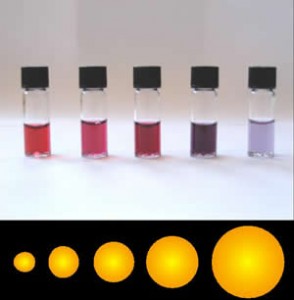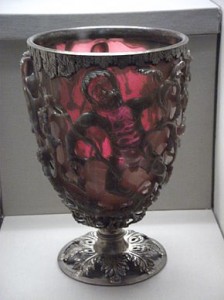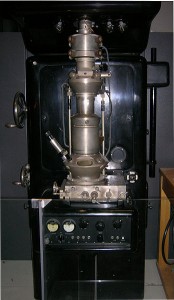
I first came across the intriguing world of nanoparticles when I saw an awe-inspiring talk by nano-extraordinaire Professor Michael Hochella from Virginia Tech at the Geological Society. He wove a fascinating tale about the world at nanoscale, the special properties, the infinite uses and the potential environmental impacts as well as outlining the need for caution, scrutiny and intensive research from the scientific community in the wake of an exploding nanotechnology industry. I’ve decided to re-visit the area of nanoscience for the ‘Momentous Discoveries in Geology’ blog festival.
What’s so special about Nanoparticles?

Solutions of gold nanoparticles of various sizes. The size difference causes the difference in colors. Source – Aleksander Kondinski, Wikimedia Commons.
Nanoparticles refer to particles between 1 and 100 nanometers in size and can be found in nature, inadvertently produced by humans or most recently, manufactured as part of the boom in nanotechnology. Their geo-relevance comes from both their behaviour in nature and potential nanotoxicity but also in their manufacture for engineering processes such as environmental tracers and remediation materials. Nanoparticles are unique and special in their physical properties, which can vary greatly from macro-scale properties. Nanotechnology exploits these unusual properties to improve the efficiency and sustainability of already existing processes. They are highly mobile, have enormous specific surface areas, unexpected optical properties and can exhibit what are known as quantum effects. An example being: superparamagnetism (magnetization that can randomly flip direction under the influence of temperature) a characteristic found in ferromagnetic materials smaller than 10nm. Nanoparticles can also have unusual optical properties: gold nanoparticles for example appear deep red to black in solution, depending on their size. They also melt at much lower temperatures (~300 °C for 2.5 nm size) than gold slabs (1064 °C). Their first known use for their colour-changing properties was back in roman times (30BC – 640AD), using gold nanoparticles, which were impregnated into the glass of

The Lycurgus Cup – a 4th-century Roman glass cage cup , which shows a different colour depending on whether or not light is passing through it; red when lit from behind and green when lit from in front due to the incorporation of nanoparticles – You can go and see it in the British Museum! Source – Johnbod, Wikimedia Commons.
goblets to give a colour change from green to blood red when lit from behind. The requirement of the exact mixture of sizes to manifest this effect suggested that the Romans knew what they were doing!
Early history of nanoparticles
The discovery of nanoparticles has not so much happened as a single momentous discovery but as a series of moments over a ~100 year period. As with many discoveries, they are as a result of breakthroughs in instrumentation and technology which breakdown the barrier to discovery. In addition to the early use in roman times, nanoparticles were also used in the medieval (500-1450AD) and renaissance (1450-1600 AD) periods, again for their colour-changing properties for use in stained glass windows in medieval times and for colouring ceramics during the renaissance. The deep reds you see are caused by the incorporation of gold nanoparticles in the glass and the deep yellows are caused by silver nanoparticles. We also see this effect used in Ceramics. In the Islamic world, where the incorporation of gold in artistic representations was not allowed, the solution was using dense nanoparticulated layers of glaze to generate a golden metallic shine. This colour changing capacity is caused by the size of the materials that are incorporated. Photography is also an early example of nanotechnology which is reliant on the production of silvernanoparticles that are sensitive to light.
When were they discovered?

Michael Faraday – 1861. He first described the optical properties of gold nanoparticles in his classic 1857 paper. Source – Wikimedia Commons.
The earliest and most significant breakthrough came during Michael Faraday’s pioneering experiments and his seminal paper in 1857 where he described the optical properties of nanometer-scale metals for the first time. He prepared the first metallic colloids (fine particles that suspend in solution, in between dissolved and settling particles, size range between 2-500 nm). He saw that they had special electronic and optical properties and stated – “It is well known that when thin leaves of gold or silver are mounted upon glass and heated to a temperature which is well below a red heat (~500 °C), a remarkable change of properties takes place, whereby the continuity of the metallic film is destroyed. The result is that white light is now freely transmitted, reflection is correspondingly diminished, while the electrical resistivity is enormously increased.”.

First Electron Microscope with resolving power higher than that of a light Microscope designed by Ernst Ruska in 1931 with a magnification of around 12,000 times. Source – J Brew, Wikimedia Commons
While the unusual and fascinating properties of nanoparticles had been described, they were still too small to be seen and it took another 84 long years before electrical engineer Max Knott and physicist Ernst Ruska constructed the prototype electron microscope in 1931. This breakthrough put a spotlight on the “small world” and was an important step in allowing research at the nanoscale. This was followed by Erwin Mueller’s field-ion microscope which allowed the viewer, for the first time in history to observe individual atoms and their arrangement on a surface. This was a landmark invention allowing magnification of more than 2 million times. These technological developments formed the foundation for many other nano breakthroughs to come such as the ‘tunneling phenomenon’, the development of the field of molecular electronics, the development of Surface Enhanced Raman Spectroscopy (SERS), instrumental in the field of nanotechnology, the buckyball, quantum dots (which have implications for how solar energy is collected) and carbon nanotubes.
_____________________________________________________________________
This post is for a geoscience blog carnival called The Accretionary Wedge, which is being hosted by Matt Herod and you can see the call for posts here.


Pingback: The Accretionary Wedge #60 – Momentous Discoveries Summary | GeoSphere